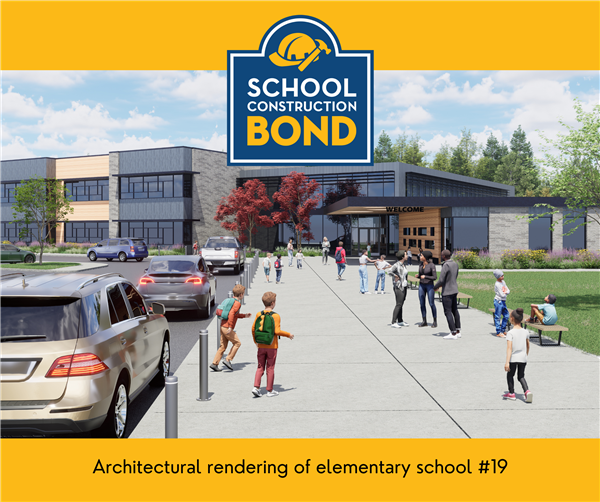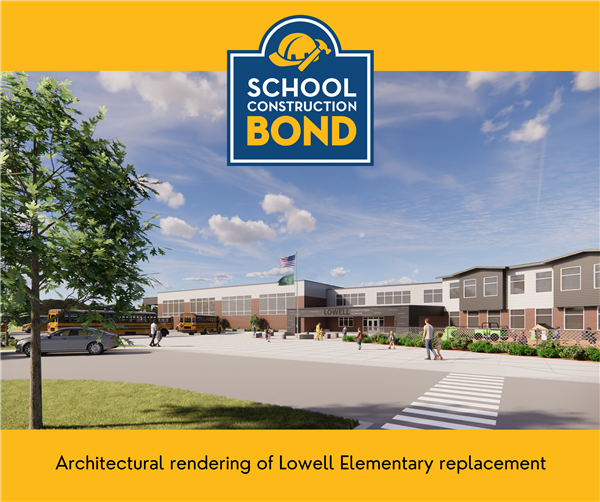- Everett Public Schools
- 2026 School Construction Bond & Education Levy
2026 School Construction Bond & Education Levy
-

Please vote by February 10, 2026
Everett Public Schools is asking voters to consider two measures on the February 10, 2026, ballot. The School Construction Bond will provide a new elementary school, replace Lowell Elementary School, update safety and security systems, and update high school facilities to expand our Career and Technical Education (CTE) programs. The Education Levy continues to fund staffing, services, and programs for students, making up 15% of the district’s budget. The Education Levy helps fill the gap between the state funds and the cost of our district’s operations.
Informational Flyer
List of Proposed Bond Projects
School Construction Bond (Proposition 1)
-

Provides students space to learn in permanent classrooms
-
The district currently uses 103 portable classrooms at our elementary schools — enough to fill 2.5 elementary schools.
-
If approved, this bond would fund the construction of a new elementary school and add 12 additional classrooms to existing schools, reducing the number of portable classrooms.
Funds safe and healthy school buildings to meet today’s learning needs
-
Replace Lowell Elementary to meet today's safety and learning standards.
-
Replace Cascade High School’s library/cafeteria and performing arts building, renovating these facilities while adding additional classrooms.
-
Renovate Everett High School’s vocational building that houses our CTE, Career Connected Learning, and special education programs.
-
Improve and integrate our safety and security systems, replace aging roofs, HVAC systems, and playgrounds, and change two middle school fields to synthetic turf.
Builds space for STEM and career-connected learning
-
Builds a new Career and Technical Education (CTE) and Science, Technology, Engineering, and Math (STEM) building at Cascade High School.
-
The new building will make these programs more accessible to students across the district.
School Construction Bond cost information
Bond total: $396.8 million
Approved by the community-led planning committee following months of review and input.
Architectural renderings of proposed bond projects
These architectural renderings show what the following projects could look like if the bond passes: Elementary school #19, replacement of Lowell Elementary, and replacement of Cascade High School's library, cafeteria, and performing arts building.
-



Education Levy (Proposition 2)
-

The Education Levy maintains staffing, programs, student opportunities, and day-to-day services not fully funded by the state.
Continues student programs and services-
Continues funding for academic programs like elementary STEM, Highly Capable, and Advanced Placement
- Special education staffing and support
- Everett Public Schools is underfunded in special education by approximately $12.3 million this school year.
In the past, we used levy dollars to fill that gap for students receiving special education services. Special education services include speech therapy, classroom aides, modified curriculum, and behavioral support. A new state rule now prohibits the use of local levy funds for special education. The proposed 2026 levy will now fill the underfunding gap across all areas.
- Everett Public Schools is underfunded in special education by approximately $12.3 million this school year.
Provides student support and opportunities
-
Classroom support teachers, custodians, health room staff, and technology support - positions not fully funded by state resources
-
Mental health supports for students, including counselors and social workers
-
Student opportunities like art, music, drama, and athletics
Funds the day-to-day operational costs for our schools
-
Covers daily operations, including utilities, classroom materials, supplies, security systems, and facility maintenance
-
Helps fill the gap between state funding and the operational costs of the district
Education Levy cost information
This is not a new tax. It renews an expiring local levy. This proposal would renew the existing levy that is set to expire at the end of 2026.
Tax rates are expected to remain stable, with an annual adjustment to account for inflation.
-
Financial Overview
-
- Combined proposals reestablish a stable tax rate with a $0.30 per $1,000 Assessed Value (AV) increase
- This includes $0.21 for Proposition 2, Education Levy, and $0.09 for Proposition 1, the School Construction Bond
- The 2026 Education Levy and School Construction Bond combined estimated tax rate is lower than the estimated tax rate for the 2022 Education Levy and the Capital/Technology Levy of $4.08 per $1,000 AV
- The 2026 combined estimated tax rate is lower than the 10-year historical average and lower than the estimated rate from the voter-approved 2022 levies, which was $4.08
Frequently Asked Questions
-
What is a School Construction Bond?
A School Construction Bond is a funding measure that allows the district to address facility needs, including new construction, renovations, and safety improvements. The funds can only be used for capital projects, not daily operating expenses.
-
What is an Education Levy?
An Education Levy is a local funding measure that provides resources for school programs and services that are not fully covered by state funding. It must be renewed by voters every four years. Most districts in Washington state seek an education levy every 2-4 years.
-
Why does the district need a bond and levy?
The bond is needed to address aging facilities and limited classroom capacity. The levy ensures continued funding for educational programs and operations, staffing, and student services. The levy makes up about 15% of our budget.
-
Why did the district propose a school construction bond instead of a levy?
With a bond, the district receives the funding up front, which allows us to fund major construction projects at today’s construction prices, reducing the impact of price escalation. Then we pay off the bond over a 20-year period. With a levy, the district collects funding every year for a shorter period, and not enough is collected upfront to fund major construction.
-
How will this bond impact property taxes?
- Combined proposals reestablish a stable tax rate with a $0.30 per $1,000 Assessed Value (AV) increase
- This includes $0.21 for Proposition 2, Education Levy, and $0.09 for Proposition 1, the School Construction Bond
- The 2026 Education Levy and School Construction Bond combined estimated tax rate is lower than the estimated tax rate for the 2022 Education Levy and the Capital/Technology Levy of $4.08 per $1,000 AV
- The 2026 combined estimated tax rate is lower than the 10-year historical average and lower than the estimated rate from the voter-approved 2022 levies, which was $4.08
-
What does the deferred maintenance and improvement list look like for the next 5-10 years?
Everett Public Schools maintains a long-range facilities plan that identifies and prioritizes building maintenance and improvement projects across the district. This plan is based on regular building condition assessments, safety inspections, and input from school staff and maintenance professionals.
The list includes projects such as:
- Roof replacements and repairs
- Heating, ventilation, and air conditioning (HVAC) system upgrades
- Plumbing, electrical, and safety system improvements
- Flooring, paint, and building exterior maintenance
- Accessibility and energy efficiency upgrades
Projects are prioritized based on safety, urgency, impact on learning, and cost efficiency. The district updates this plan regularly to ensure resources are used effectively and that facilities remain safe, functional, and conducive to learning.
-
What happens if the bond does not pass?
If the bond does not pass, Everett Public Schools will not be able to move forward with the construction of a new elementary school, modernization of Cascade High School, permanent classroom additions, replace Lowell Elementary, and other major facility improvements designed to meet growing enrollment needs. Without these funds, the district will continue to rely on portable classrooms to manage overcrowding, and critical infrastructure projects will need to be delayed, such as replacing aged flooring, roofing, and heating & ventilation (HVAC) systems.
Over time, the cost of maintaining and repairing aging facilities will increase, and schools may face more frequent issues with heating, roofing, and other building systems. This would also limit the district’s ability to update learning spaces to meet current instructional and safety standards. While the district will continue to prioritize student safety and learning, the lack of bond funding would make it difficult to maintain the same level of quality, innovation, and long-term planning our community expects.
-
What happens if the levy does not pass?
If the levy does not pass, the district will not have the funding needed to continue important student programs, classroom support, and safety and technology services. These costs are not covered by the state, so the district would need to make reductions that could include fewer staff, fewer student opportunities, and cuts to school-based support.
-
How are decisions being made regarding which elementary schools get additions and which ones get portables?
Everett Public Schools uses a comprehensive process to determine how to best meet facility needs across the district. Decisions about additions or portables are based on several factors, including:
- Current and projected enrollment trends: District planners analyze student enrollment data, birth rates, and residential development to project future growth at each school.
- Building capacity and space utilization: Schools are evaluated to determine how well existing classrooms and common areas can support current and future student populations.
- Site feasibility: Some school sites have the space and infrastructure to accommodate permanent additions, while others can only support temporary portables due to property size, topography, or access limitations.
- Cost effectiveness and timing: Permanent additions are prioritized where long-term growth is expected, while portables provide flexibility in areas where enrollment fluctuations may change over time.
- Educational impact: The goal is to ensure all students have safe, effective learning environments that support the district’s instructional goals.
This process is reviewed regularly as enrollment patterns evolve and as the district continues to plan for both short-term and long-term facility needs.

